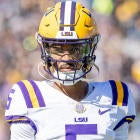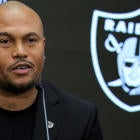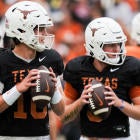CBSSports.com Senior College Football Columnist Dennis Dodd spent the offseason investigating the issue of concussions in college football -- the background on the issue, the competing interests at play in the current debate, and the way forward for the sport. The details of Dodd's reporting will be revealed in a multi-part series throughout the week, with previous installments of the series indexed HERE.
Brian Hainline cannot be blamed for sloth.
Since being named the NCAA’s first chief medical officer in January, he has traversed the country trying to connect with the membership on various topics. Chief among them is the concussion issue. Hainline, formerly the chief of neurology at ProHEALTH Care Associates in Lake Success, N.Y., is a ray of hope in what has become an at-times disjointed national approach to concussions.
There is an ongoing NFL lawsuit that should be a legal benchmark for cases to come. Elsewhere, some experts advocate no tackle football before the age of 14. Other experts note with caution that the brain is still maturing sometimes all the way to age 24.
While Hainline can’t be an overall unifying voice, he is accessible, articulate and energetic. In this Q & A, he addresses the work ahead.
CBSSports.com: The Pac-12 and Ivy League have limited full contact practices to twice a week. Is it the NCAA’s role to maybe one day limit contact themselves?
Hainline: It’s not so black and white like that … It’s not so much that the Pac-12 is saying, 'We’re going to take the lead,' and the SEC is saying, 'We're waiting for the NCAA.' As you can probably appreciate, there are a lot of intense conversations. Different conferences may have different views about how to roll something out. None of this is happening in a void.
What’s important, and what we’re moving to, is coming out with a general sense of an agreement. I’m not convinced right now the NCAA can say, ‘This is the way it must be done.'
CBSSports.com: Your hiring says something about how seriously the NCAA takes this issue. You told me the concussion issue takes up about half your time on the job.
Hainline: The creation of this position is hugely important. I’ve been around the block in 25 years in sports medicine work and neurology work. I know this isn’t an easy task. At the NCAA and member institution level, one of my biggest tasks is building bridges with new sports. Quite frankly I think the concussion dialogue certainly has gotten everyone’s attention.
CBSSports.com: When did this become a front burner issue in sports?
Hainline: If you talk to the people who have been in the field of concussions over the last 20 years -- 20 years ago, 10 years ago you couldn’t get anyone to write about concussions. They were way in the background. When everything coalesced is when [the former NFL players’ lawsuit was filed]. It was clear that there was a lot of controversy … There was a critical time when the NFL had to step up. It’s not so crystal clear.
I’m reasonably optimistic in the next three years we’re going to have a much better take on it. A concussion is the only neurological condition where the gold standard brain imaging study is a CAT Scan. We haven’t defined any of our parameters.
The question is, ‘What’s the best way to define a concussion?’ You don’t want it to be defined by an imaging study. We’re defining very broadly and generally and it’s not good enough. It’s not going to happen overnight. I really believe there is a [chance] for everyone to come out on the same page. My impression is everyone wants to work together and get this right. I don’t think we’re going to bully our way into saying, ‘This is what’s going to happen.'
CBSSports.com: What about perception that Chronic Traumatic Encephalopathy (CTE) is a direct result of football? (CTE -- a degenerative brain disease -- has been blamed for the death of former NFL players including Dave Duerson, who committed suicide.)
Hainline: Is tau protein [that gathers in the brain in CTE] progressive or does that wax and wane? The more profound question is that we take a giant step back and don’t look at that with a microscope. The one issue that everyone agrees to be addressed is student-athlete mental health. The question is, ‘What are all the predisposing factors to someone committing suicide?’ There is a shockingly high rate in our country and a shockingly high rate among athletes.
Where do concussions come into this? Where does drug use come into this and where does post-traumatic stress come into this?
CBSSports.com: There has to be a concern about that NFL class-action litigation hitting colleges.
Hainline: In my own practice of medicine I’ve been sued and in each case it’s been because of a bad outcome [perceived by a patient]. I can say in my heart of hearts that it was not because I did something wrong … We’re looking so much at football and we aren’t taking a step back and looking at all of our sports. Women manifest [concussions] differently than men. Their concussions are longer. They’re more vulnerable. In some sports they have a higher concussion rate than men … Women don’t have the same muscle support on their necks as men. There is no helmet in the world that will protect you against a concussion. Most concussions come from rotational acceleration.
CBSSports.com: There seem to be so many divergent views on the subject. Doesn’t there need to be some sort of unity?
Hainline: I think the focus is becoming centralized. These consensus makers -- Zurich Consensus, American Medical Society of Sports Society, American Academy of Neurology --all came out this year within a six-month span. They all said very similar things about the definition of concussions.
They all said virtually identical things about return to play. They all said similar things about helmets. The evidence states helmets do protect you from catastrophic injuries. They protect you from skull fracture, from cerebral bleeds and …. fractures. The evidence that they can protect you from concussions is very weak. The reason is because the helmets don’t protect you from rotational forces.
CBSSports.com: How would you quantify where this issue is as a percentage of your job?
Hainline: I don’t know if it’s half my job but certainly every day I’m dealing with it. I think 50 percent is close. There’s an awful lot of attention we’re putting on equally compelling issues.
We are having a comprehensive overview of our whole doping program. We’re going to have a much more focused effort on the [issue of] performance-enhancing drugs. Stimulants have actually have become a major problem on college campuses.
CBSSports.com: What’s football going to look like in 10 or 20 years?
Hainline: That’s assuming football is going to be around in 10 or 20 years. If it is, I really hope it is. I think it’s a great sport.
Concussions and college football
Part I: Ex-player's case takes aim at NCAA
Q&A: NCAA's chief doctor answers questions
Part II: Ex-QB Klatt puts onus on NCAA
Part III: Stiles' death may unravel mystery
Part IV: Will college football change? Yes
Quotable: Notable thoughts on concussions




















